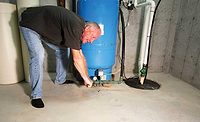Tool Tips: Circulator pumps, sump pump cords, spotty fixtures

Installing circulator pumps.
Installing circulator pumps
Installing boilers is a craft that, done well, takes much skill and often lots of time. True hydronic craftsmen pipe everything level and plumb, ensuring that the system piping will be in place long after they are dead and gone. A time saver that I use is a “circulator blank” (pictured). The blank is lighter than an actual circulator, provides the same gap needed to slip in a circulator, and allows soldering of pump flanges without removing the gaskets, only to reinsert them afterwards.
I made mine with leftover 1 1/4-in. iron flags and a 6-in. black nipple. I made the end-to-end length 6 3/4-in. This allows for easy insertion of a typical 6 1/2-in. circulator with the gaskets on and enough “wiggle room” to slip it in. It works well even with swivel-type pump flanges to set the proper gap. I plan to make a lighter version using 1/2-in. pump flanges rather than the 1 1/4 in. I hope this saves you some time and keeps your pipe runs straight and sturdy.
Jeremy Graham
Advanced Hydronics
Denver
Sump pump cord storage
Our company primarily does new construction, so installing sump pumps is done on a regular basis. We have found many times the power cord will get tangled with the float, causing the pump to malfunction. A simple solution is to put the cord through the handle of the pump, keeping the cord from getting tangled. This has saved time, money and call-backs.
Tom Dumas
TC Plumbing
Pataskala, Ohio
No more spots
Are you tired of water spots and fingerprints on your kitchen and bathroom fixtures? Use wax paper and rub it on your fixtures. It will keep them shiny, and prevent water spots and fingerprints.
Ben Elsen
Balaton, Minn.
Send Us Your Tool TipsIf you have an idea that has saved you time and money, Plumbing & Mechanical would like to share your tip with our readers.The first-place winner each month will receive a Kinetic Water Ram from General Pipe Cleaners with a retail value of $325. Read here for more details.
|
Looking for a reprint of this article?
From high-res PDFs to custom plaques, order your copy today!






